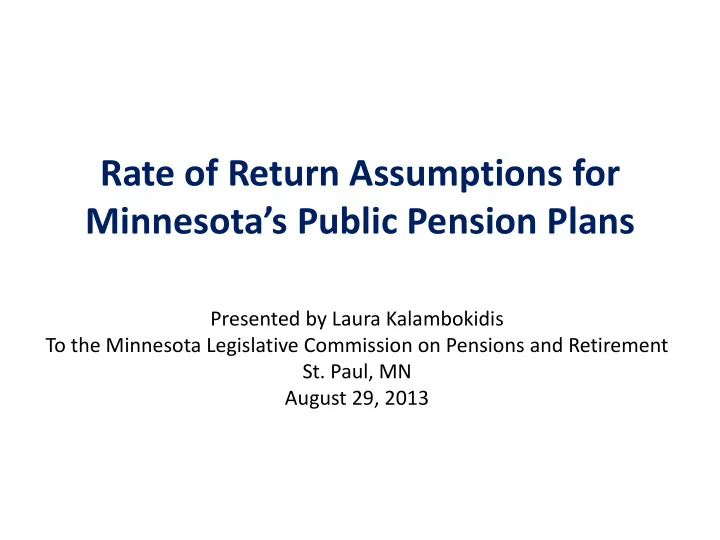

Rate of Return Assumptions for Minnesota’s Public Pension Plans Presented by Laura Kalambokidis To the Minnesota Legislative Commission on Pensions and Retirement St. Paul, MN August 29, 2013
Expected Rate of Return Assumptions for Public Pensions Expected rate of return assumptions are used to compare the current value of pension assets with future pension liability. Two common purposes: 1. Project the future returns on pension fund assets. 2. Adjust future pension liabilities to present-day value. • Obtaining present-day value requires discounting future pension benefit payments by an interest rate. • Provides consistent value comparisons of benefit payments that don’t necessarily occur at the same time.
Future Economic Performance Affects the Expected Rate of Return • New Normal: – Population is aging – Labor force growth is slowing – Ongoing federal fiscal risks • Probably Means: – Slower economic growth – More uncertainty about the future • In other words, past performance does not guarantee future results.
U.S. Real GDP growth is expected to average just 2.5% per year over the next 30 years, well below the 3.1% 20yr average prior to the Recession. Annual Percent Change in U.S. Real GDP 5% 4% Avg: 3.1% 3% Avg: 2.5% 2% 1% 0% Global Insight Long-Term Trend Forecast -1% -2% Source: U.S. Bureau of Economic Analysis (BEA); Global Insight (GII) -3% 1985 1990 1995 2000 2005 2010 2015 2020 2025 2030 2035 2040
CPI inflation is expected to average 2.0% annual increases over the next 30 years, somewhat less than the 3.0% avg between 1982-2012. Percent Change in Consumer Price Index (CPI) 14% 12% 10% 8% 6% 4% Avg: 3.0% Avg: 2.0% 2% Global Insight Long-Term Trend Forecast 0% 1975 1980 1985 1990 1995 2000 2005 2010 2015 2020 2025 2030 2035 2040 Source: U.S. Bureau of Labor Statistics (BLS); Global Insight (GII)
In the long run, baby boomer retirements are expected to cause federal budget deficits to grow. Annual Federal Deficit as % of GDP 4% 2% 0% Global Insight Long-Term Trend Forecast -2% -4% -6% -8% -10% '60 '65 '70 '75 '80 '85 '90 '95 '00 '05 '10 '15 '20 '25 '30 '35 '40 Source: U.S. Bureau of Economic Analysis; Global Insight (GII)
Two Leading Approaches for Valuing Future Pension Liabilities 1. GASB Guidelines: – Discount future benefit payments based on the expected rate of return on plans’ assets. – Implicitly assumes future investment returns are just as certain as benefit payments . 2. “Fair - Value” method: – Discount by a market rate that reflects the risk characteristics of the obligations. – Accounts for the different risks associated with investment returns and benefit payments. Source: Congressional Budget Office (CBO)
Select Discount Rates for Measuring Pension Plans’ Liabilities Percent 14% 14% Minnesota's Investment Return Assumption* Yield on Aaa Municipal Bonds (adjusted to obtain taxable yields)** 12% 12% Yield on Aaa Corporate Bonds *** Yield on 10-yr Treasury Bonds **** 10% 10% 8.0% or 8.5% 8% 8% 6.7% 6.0% 6% 6% 4.3% 4% 4% 2% 2% IHS Global Insight Long-Term Trend Forecast 0% 0% '60 '65 '70 '75 '80 '85 '90 '95 '00 '05 '10 '15 '20 '25 '30 '35 '40 * Under guidelines recommended by the Government Accounting Standards Board (GASB), S&L governments typically discount future pension obligations based on the expected rate of return on the plans’ assets. Or “GASB Guidelines” . Source: Munnell, Alicia and others. “ The Funding of State and Local Pensions: 2012:2016 ” Center for Retirement Research at Boston College, July 2013. ** Concept similar to what the Congressional Budget Office (CBO) describes as appropriate for discounting pension liabilities. Or “CBO Fair - Value” approach. Source: Congressional Budget Office (CBO). “ The Underfunding of State and Local Pension Plans ” May 2011. *** Concept similar to Moody’s new methodology for analyzing and comparing state and local government pension liabilities as well as to standards set by the Financial Accounting Standards Board (FASB) for private sector DB plans. Or “Moody’s & FASB Guidelines” . Source: Moody’s. “ Adjustments to US State and Local Government Reported Pension Data ” July, 2012; Novy-Marx, Robert, and Joshua Rauh. “ Public Penson Promises: How Big Are They And What Are They Worth ” Journal of Finance, 2011: 1211-1249. **** Concept recommended by some experts as the “Riskless R ate” approach. Source: Pew Center on the States. “The Widening Gap: The Great recession’s Impact on State Pension and Retiree Healthcare Costs” April, 2011.
Impact of Discount Rate Assumption • Each measure indicates the difference in risk to receiving future benefit payments. – Pension payments guaranteed low-risk rate – Pension payments not guaranteed higher-risk rate • Getting the discount rate wrong has consequences. – Too low overstate liabilities unnecessary costs today – Too high understate liabilities pushes costs to future
Summary • Uncertainty about near-term economic performance suggests caution about raising assumed investment rate of return. • Common view in economics and finance recommends a “Fair Value” approach to calculating the present value of lower risk pension obligations.
Recommend
More recommend